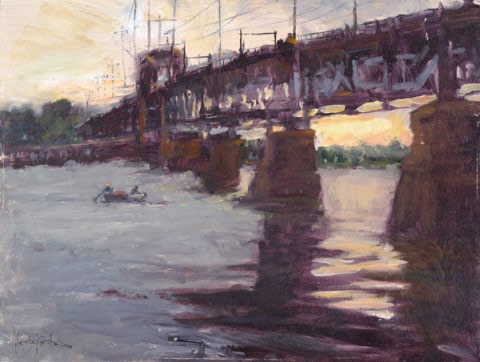
The Mid-Atlantic Plein Air Painters Association seems to be bucking some trends currently popular in plein air groups, and the underlying cause is a dedication to fostering the development of all of its members, regardless of their skill level. How are they doing this?

“Wissahickon at Bell’s Mills,” by Alyce Grunt
Cash prizes draw participants, and quick draws attract the public. Competitions sharpen artists and push them to cast a critical eye upon their own work. But it can all be too much, and can simply reward the best among an association’s members. Stewart White is the new president of the Mid-Atlantic Plein Air Painters Association, and he seems determined to follow a different path. “We are organized to benefit the members of MAPAPA and not just the few who are pros or semi-pros,” says White. “We would like to step away from the competitive environment and just provide opportunities to paint without pressure or comparisons. Our goal is to foster confidence and fellowship among outdoor painters. We do that through education as well as by exposing the members to the vast diversity of styles of painters through history at our annual meeting. Eventually we will have to have some judgment in creating a ‘competent’-looking show. But the last thing we want is to channel everyone into a narrow definition of what a plein air painting ‘should’ look like.”

“Tree Bones,” by Sid Branham
While many associations pursue publicity and seek a higher profile, MAPAPA spreads its marketing more widely to include events that are for only a few art collectors. The group plans events like a paint-out at Chadds Ford that is designed to be small and intimate. “It was right there on Koerner’s Farm,” White says about a previous paint-out in the countryside notably depicted by Andrew Wyeth. “I looked up and saw the same bucket Wyeth painted. It was like stepping into a museum. It was like walking into a Vermeer and seeing the maps on the wall.”
Like a few other plein air groups, MAPAPA is somewhat decentralized, with members organizing paint-outs in their towns and the association spreading the word about the opportunities. The association is in the midst of a yearlong celebration of urban plein air, one that will culminate in a show held in the Charles Willson Peale Museum in Baltimore, the first building designed and built in America for the purpose of housing a museum.

“Falling Leaves,” by Ann Crostic
“Half of the proceeds will go to the museum,” says White. “We’re taking prizes out of the picture, but there is a reputable judge, and sponsors. But mostly, we’re trying to take the pressure off of trying to please a judge and focus on your individual response to a landscape. I think this structure will help. Cash prizes are fine, but I want to move away from that and remove that thing about making a killer painting, or not being the one that got picked. It’s not the right focus.”
Anything that draws from the entire membership and benefits only a few is anathema to MAPAPA’s current leadership. “One of the things we don’t want to have happen is to have newer members subsidizing all the events for the other painters,” says White. “We want to find out what best serves general membership, not just select stars. Let them reward themselves on their own. We want to make it easy for all to go outside and paint and feel comfortable and have their own personal growth.”




